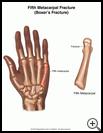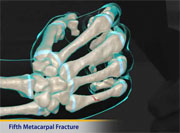
Hand Fracture: Fifth Metacarpal (Boxer's) Fracture
What is a boxer’s fracture?
A boxer’s fracture is a break in the bone in the hand that attaches to the pinky finger. The long bones in the hand are called metacarpals.
A boxer’s fracture is also called a fifth metacarpal fracture.
What is the cause?
A boxer’s fracture can happen when your child hits a hard object with their fist. It may also happen if your child falls onto their hand.
What are the symptoms?
Symptoms may include:
- pain, swelling, or tenderness on the pinky finger side of the hand
- a bump on the side of the hand
- a crooked looking hand
How is it diagnosed?
Your provider will ask about your child’s symptoms and how the injury happened. He or she will examine your child. Your child will have X-rays of the hand.
A child's bones are different from an adult’s bones in a couple ways. A child’s bones are more flexible and may crack rather than break. Or they may just buckle slightly. Also, the bones are still growing from areas near the ends of the bones called growth plates. A fracture in a growth plate may affect the growth of the bone but it may be hard to see with X-rays. Sometimes special tests are needed to diagnose fractures in the growth plate.
How is it treated?
If the broken bone is crooked, your healthcare provider will straighten it. Your child will be given medicine first so the straightening is not painful. Sometimes surgery is needed to put the bones back into the correct position.
Your healthcare provider will put your child’s hand and forearm in a cast to keep the hand from moving while it heals.
How can I take care of my child?
Follow the full course of treatment your healthcare provider prescribes. Also:
- To keep swelling down and help relieve pain, your healthcare provider may tell you to:
- Put an ice pack, gel pack, or package of frozen vegetables wrapped in a cloth on the injured area every 3 to 4 hours for up to 20 minutes at a time for the first day or two after the injury.
- Keep the injured hand up on pillows when your child sits or lies down.
- Give your child pain medicine, such as ibuprofen, as directed by your provider. Nonsteroidal anti-inflammatory medicines (NSAIDs), such as ibuprofen, may cause stomach bleeding and other problems. These risks increase with age. Read the label and take as directed. Unless recommended by your healthcare provider, your child should not take the medicine for more than 10 days. Check with your healthcare provider before you give any medicine that contains aspirin or salicylates to a child or teen. This includes medicines like baby aspirin, some cold medicines, and Pepto-Bismol. Children and teens who take aspirin are at risk for a serious illness called Reye's syndrome.
- If your child has a cast, make sure the cast does not get wet. Cover the cast with plastic when your child bathes. Avoid scratching the skin around the cast or poking things down the cast. This could cause an infection.
Depending on the type of injury and how it was treated, your child may need to do special exercises to help the arm and hand get stronger. Most of the time preteen children are so active that they get stronger and more flexible without physical therapy.
Keep all appointments for provider visits or tests. Call your healthcare provider if:
- Your child has more pain, redness, warmth, or swelling.
- Your child has a fever.
- Your child has a loss of feeling in the injured area.
- The injured area looks pale or blue or feels cold.
How long will the effects last?
Boxer’s fractures usually heal within 6 weeks.
When can my child return to normal activities?
Everyone recovers from an injury at a different rate. Return to your child's activities depends on how soon the hand recovers, not by how many days or weeks it has been since the injury occurred. The goal is to return them to normal activities as soon as safely possible. If your child returns too soon the injury may get worse. Your child may start rehabilitation exercises when the healthcare provider has taken a follow-up X-ray and sees that the fracture has healed.
Your child may return to normal activities when the hand has full range of motion without pain and has the same strength as the uninjured hand.
How can a boxer’s fracture be prevented?
Try to avoid hitting hard objects with the fist.
Last modified: 2012-02-08
Last reviewed: 2012-01-02


